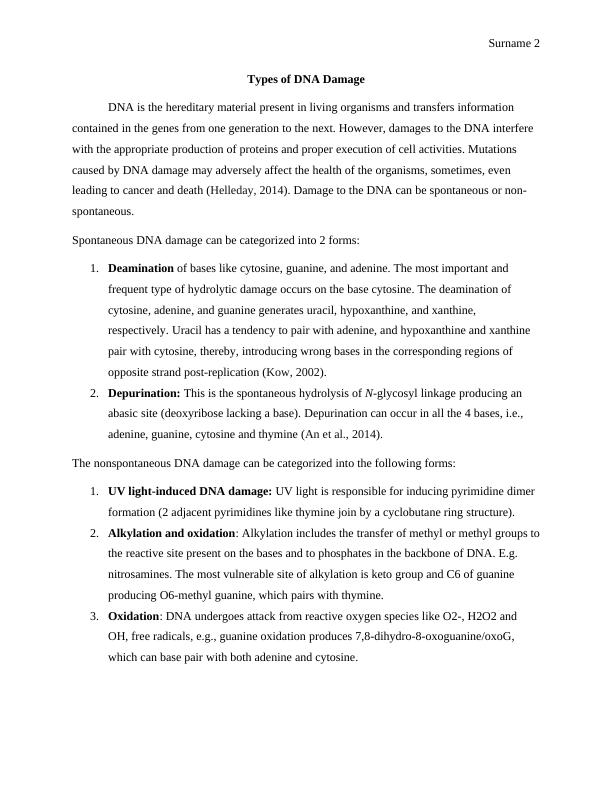Ask a question from expert
Types of DNA Damage
4 Pages549 Words269 Views
Added on 2020-01-16
Types of DNA Damage
Added on 2020-01-16
BookmarkShareRelated Documents
Surname 1Types of DNA DamageStudent’s nameInstructor’s nameCourseDate

Surname 2Types of DNA DamageDNA is the hereditary material present in living organisms and transfers information contained in the genes from one generation to the next. However, damages to the DNA interfere with the appropriate production of proteins and proper execution of cell activities. Mutations caused by DNA damage may adversely affect the health of the organisms, sometimes, even leading to cancer and death (Helleday, 2014). Damage to the DNA can be spontaneous or non-spontaneous.Spontaneous DNA damage can be categorized into 2 forms:1.Deamination of bases like cytosine, guanine, and adenine. The most important and frequent type of hydrolytic damage occurs on the base cytosine. The deamination of cytosine, adenine, and guanine generates uracil, hypoxanthine, and xanthine, respectively. Uracil has a tendency to pair with adenine, and hypoxanthine and xanthine pair with cytosine, thereby, introducing wrong bases in the corresponding regions of opposite strand post-replication (Kow, 2002).2.Depurination: This is the spontaneous hydrolysis of N-glycosyl linkage producing an abasic site (deoxyribose lacking a base). Depurination can occur in all the 4 bases, i.e., adenine, guanine, cytosine and thymine (An et al., 2014).The nonspontaneous DNA damage can be categorized into the following forms:1.UV light-induced DNA damage: UV light is responsible for inducing pyrimidine dimer formation (2 adjacent pyrimidines like thymine join by a cyclobutane ring structure).2.Alkylation and oxidation: Alkylation includes the transfer of methyl or methyl groups tothe reactive site present on the bases and to phosphates in the backbone of DNA. E.g. nitrosamines. The most vulnerable site of alkylation is keto group and C6 of guanine producing O6-methyl guanine, which pairs with thymine.3.Oxidation: DNA undergoes attack from reactive oxygen species like O2-, H2O2 and OH, free radicals, e.g., guanine oxidation produces 7,8-dihydro-8-oxoguanine/oxoG, which can base pair with both adenine and cytosine.

End of preview
Want to access all the pages? Upload your documents or become a member.
Related Documents
Plant Flavonoids on Cancer Treatmentlg...
|16
|4183
|388